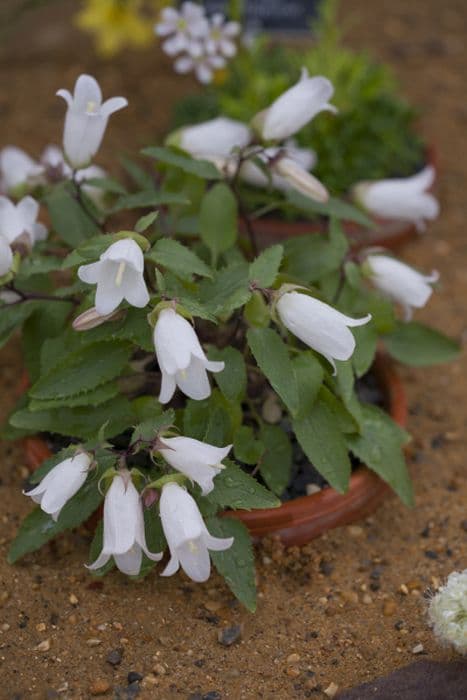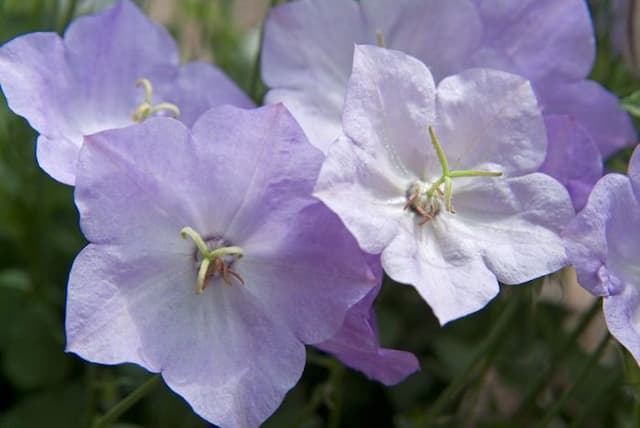Dalmatian Bellflower Campanula portenschlagiana

ABOUT
The plant known as Dalmatian bellflower features a low-growing, mat-forming habit with small, heart-shaped, green leaves that are notably textured. It is characterized by its showy, violet-blue, upturned, bell-shaped flowers which bloom profusely. These blossoms cluster together, creating a striking display above the foliage during their blooming season. This plant tends to spread across its growing surface, creating a blanket-like effect which is often used in garden designs as groundcover. The Dalmatian bellflower typically has a lush, dense appearance, which can add a touch of charm to any garden setting.
About this plant
 Names
NamesSynonyms
Dalmatian Bellflower, Adria Bellflower, Wall Bellflower.
Common names
Campanula muralis, Campanula L., Campanula affinis, Campanula cespitosa, Campanula petraea, Campanula portenschlagii, Campanula poscharskyana, Campanula turbinata, Campanula zimmermannii, Symphyandra portenschlagiana.
 Toxicity
ToxicityTo humans
Dalmatian Bellflower is generally considered non-toxic to humans. There is no widespread documentation on cases of poisoning from ingestion of this plant in humans, and it is not commonly listed among plants of concern for human toxicity.
To pets
Dalmatian Bellflower is also generally deemed non-toxic to pets, including cats and dogs. There is no significant evidence that indicates ingestion of this plant causes poisoning in pets. Therefore, it is unlikely to see symptoms of toxicity in pets from this plant. However, ingestion of any plant material may cause mild gastrointestinal upset in some animals due to the ingestion of non-digestible matter.
 Characteristics
CharacteristicsLife cycle
Perennials
Foliage type
Evergreen
Color of leaves
Green
Flower color
Purple
Height
0.5 feet [15 cm]
Spread
1 feet [30 cm]
Plant type
Herb
Hardiness zones
4
Native area
Southeastern Europe
Benefits
 General Benefits
General Benefits- Easy to grow: Campanula portenschlagiana, commonly known as Dalmatian Bellflower, is a hardy plant that thrives in a range of conditions and requires minimal care.
- Attractive flowers: It produces showy, purple-blue flowers that add a vibrant pop of color to gardens and landscapes.
- Ground cover: The plant's low-growing, spreading habit makes it an excellent ground cover that can help control weeds.
- Drought tolerance: Once established, the Dalmatian Bellflower is relatively drought-tolerant, making it suitable for dry climates or water-efficient gardening.
- Wildlife attractant: Its flowers attract pollinators like bees and butterflies, supporting biodiversity.
- Long blooming period: The plant has a lengthened blooming period from late spring to early autumn, providing long-term visual interest in the garden.
- Rock gardens and borders: With its cascading growth, it's an ideal choice for embellishing rock gardens and softening the edges of borders.
- Container gardening: Campanula portenschlagiana is suitable for container growing, allowing those with limited space to enjoy its beauty.
 Medical Properties
Medical PropertiesThis plant is not used for medical purposes.
 Air-purifying Qualities
Air-purifying QualitiesThis plant is not specifically known for air purifying qualities.
 Other Uses
Other Uses- Dye production: The flower extracts of Dalmatian bellflower can be used to produce a natural dye for fabrics or art projects.
- Edible flowers: Dalmatian bellflower's blooms can be used as an edible garnish for salads and desserts, adding a splash of color and a mild floral taste.
- Buttonhole decoration: The small, attractive flowers of the Dalmatian bellflower can be used as natural decorations for buttonholes in suits or dresses for special events.
- Crafts and potpourri: Dried flowers and leaves of the Dalmatian bellflower can be added to potpourri mixes or used in various crafts such as wreaths and flower arrangements.
- Fairy gardens: Due to its petite size and enchanting appearance, Dalmatian bellflowers are often used to create magical fairy gardens.
- Photography: With its picturesque blooms, the Dalmatian bellflower serves as a beautiful subject or backdrop for floral photography.
- Educational tool: This plant can be used in botanical studies for educational purposes, teaching about the Campanula genus and its characteristics.
- Thematic gardens: The Dalmatian bellflower can be included in medieval or cottage-style garden themes for its old-world charm.
- Ice cubes: Frozen Dalmatian bellflower blooms in ice cubes can add an aesthetic touch to summer drinks while keeping them cool.
- Frost resistance indicator: The hardiness of the Dalmatian bellflower makes it useful as an indicator plant to assess the suitability of other species in colder climates.
Interesting Facts
 Feng Shui
Feng ShuiThe Dalmatian bellflower is not used in Feng Shui practice.
 Zodiac Sign Compitability
Zodiac Sign CompitabilityThe Dalmatian bellflower is not used in astrology practice.
 Plant Symbolism
Plant Symbolism- Gratitude: Campanula portenschlagiana, also known as Dalmatian Bellflower, often represents gratitude. The bell shape of the flowers is associated with the act of ringing bells to give thanks or to show appreciation.
- Constancy and perseverance: This plant is a hardy perennial that returns year after year, making it a symbol of constancy. Its ability to grow in a variety of conditions also reflects perseverance.
- Versatility: The Dalmatian Bellflower can thrive in both sunny and partially shady environments, symbolizing adaptability and versatility in life.
- Humble beauty: Although they are not the most flashy flowers, they possess a simple charm, symbolizing the beauty in humility and the understated.
 Water
WaterFor the Dalmatian bellflower, ensure that the soil is kept evenly moist but not waterlogged; typically, this means watering thoroughly when the top inch of soil feels dry to the touch. This may equate to watering approximately once a week, but this frequency can change depending on environmental factors such as temperature and humidity. When watering, aim to use about one gallon of water per square foot every time, being careful to avoid splashing the foliage to prevent disease.
 Light
LightThe Dalmatian bellflower thrives in bright, indirect sunlight or partial shade. It is best to place it in a spot where it can receive morning light and be protected from the harsh afternoon sun, as long exposure to direct sunlight can damage the leaves.
 Temperature
TemperatureThe Dalmatian bellflower prefers moderate temperatures and can generally tolerate a range from 30 to 80 degrees Fahrenheit. Ideally, the plant should be kept in an environment where temperatures stay between 60 and 70 degrees Fahrenheit to promote healthy growth.
 Pruning
PruningPrune the Dalmatian bellflower to remove any dead or faded flowers and to encourage a second bloom. Light pruning can be done throughout the growing season; however, a more thorough cutback is beneficial after the main flowering period, typically in late summer or fall, to maintain a compact and attractive shape.
 Cleaning
CleaningAs needed
 Soil
SoilThe best soil mix for a Dalmatian Bellflower is one that is well-draining with a mixture of loam, peat, and sand. It prefers a slightly acidic to neutral pH, ranging from 6.0 to 7.5. Amending with compost can enhance soil fertility and structure, providing a healthy environment for root growth.
 Repotting
RepottingDalmatian Bellflowers should be repotted every two to three years, typically in the spring. This allows the plant to refresh its soil and expand its root system, which is essential for healthy growth and prolific blooming.
 Humidity & Misting
Humidity & MistingDalmatian Bellflowers thrive in average room humidity levels. There is no need for high humidity; typical indoor levels are usually sufficient for this plant.
 Suitable locations
Suitable locationsIndoor
Place Dalmatian Bellflower in bright, indirect light indoors.
Outdoor
In part shade to full sun, plant Dalmatian Bellflower in well-drained soil.
Hardiness zone
4-9 USDA
 Life cycle
Life cycleDalmatian Bellflower (Campanula portenschlagiana) begins its life cycle as a seed, typically germinating when the conditions are cool and moist. Once germinated, the seedling will grow into a vegetative phase, developing a rosette of leaves at the ground level. As it matures, the plant develops a sturdy stem, and during the flowering stage, it produces bell-shaped, violet-blue flowers, usually blooming in late spring to early summer. After pollination, often by bees and other insects, the flowers form fruit capsules containing small seeds. These seeds are dispersed by wind, water, or animals, which then can give rise to new plants, continuing the cycle. The Dalmatian Bellflower is a perennial, which means after the flowering it will go dormant for the winter and regrow the following spring from the same root system.
 Propogation
PropogationPropogation time
Spring to Summer
Propogation: The Dalmatian bellflower, more commonly known as Campanula portenschlagiana, is often propagated through division, which is the most popular method. This process is best performed in the spring after the risk of frost has passed. To propagate through division, carefully dig up the plant, ensuring to keep a good amount of the root system intact. Gently separate the plant into smaller clumps, each with a portion of the root system. These clumps can then be replanted in well-draining soil, spaced about 12 inches (approximately 30 centimeters) apart, and watered thoroughly. With proper care, these new plantings will establish themselves quickly, leading to new healthy growth.









